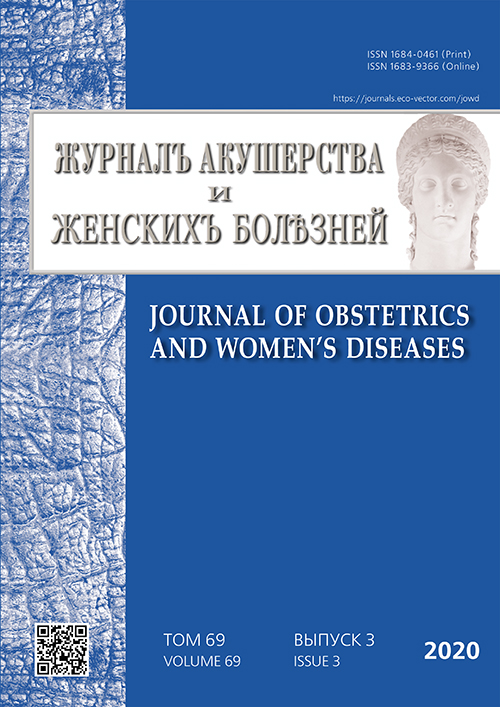Determining the cause of perinatal loss: is it always possible?
- Authors: Bezhenar V.F.1, Ivanova L.A.2, Korshunov M.Y.1
-
Affiliations:
- Academician I.P. Pavlov First St. Petersburg State Medical University of the Ministry of Healthcare of the Russian Federation
- Military Medical Academy named after S.M. Kirov of the Ministry of Defense of the Russian Federation
- Issue: Vol 69, No 3 (2020)
- Pages: 5-12
- Section: Original study articles
- Submitted: 07.08.2020
- Accepted: 07.08.2020
- Published: 11.08.2020
- URL: https://journals.eco-vector.com/jowd/article/view/42287
- DOI: https://doi.org/10.17816/JOWD6935-12
- ID: 42287
Cite item
Abstract
Hypothesis/aims of study. In the past 15 years, statistical reports have standardly identified five main causes of perinatal loss: hypoxia / asphyxia and its consequences, congenital malformations, respiratory disorders, intrauterine infections, and birth injuries. The cause of perinatal loss is indicated in 17-83% of cases, but this percentage can be increased by a careful analysis of the course of pregnancy, childbirth, and the results of autopsy. The aim of this study was to analyze the frequency of verification of the causes of perinatal death in St. Petersburg and the Leningrad Region for 2006-2018.
Study design, materials and methods. The methodology of determining the cause of perinatal loss in St. Petersburg and the Leningrad Region for 2006-2018 was analyzed according to the reports of the St. Petersburg State Budgetary Healthcare Institution “Medical Information and Analytical Center”) and the Leningrad Regional State Budgetary Healthcare Institution “Medical Information Analytical Center”, as well as the Leningrad Regional Pathological and Anatomical Bureau. Further, the frequency of cases in which the cause of perinatal loss was not indicated was estimated in dynamics over the analyzed period.
Results. The methodology and problems arising in establishing the basic diagnoses were studied: intrauterine hypoxia (P20.0), asphyxia during childbirth (P21), respiratory disorders in the newborn that occurred in the perinatal period (P22-P28), and hemorrhagic and hematological disorders in the fetus and newborn (P50-P61). Differences in the frequency of diagnosis of causes of death in Leningrad Regional Pathological and Anatomical Bureau are explained. Those are due to the methodology for establishing a diagnosis of chronic placental insufficiency (O43.8, other placental disorders: dysfunction, heart attack) based on the detection of hypoxic cardiopathy at autopsy, and due to the approach developed by the institution to detect intrauterine infections. The frequency of cases in which the cause of perinatal loss was not indicated was estimated, the reasons and possibilities of this being explained.
Conclusion. Low information content of the official statistical reports makes it difficult to analyze the real causes of perinatal loss.
Full Text
About the authors
Vitaly F. Bezhenar
Academician I.P. Pavlov First St. Petersburg State Medical University of the Ministry of Healthcare of the Russian Federation
Author for correspondence.
Email: bez-vitaly@yandex.ru
ORCID iD: 0000-0002-7807-4929
MD, PhD, DSci (Medicine), Professor, Head of the Department of Obstetrics, Gynecology, and Neonatology
Russian Federation, Saint PetersburgLidia A. Ivanova
Military Medical Academy named after S.M. Kirov of the Ministry of Defense of the Russian Federation
Email: lida.ivanova@gmail.com
ORCID iD: 0000-0001-6823-3394
MD, PhD, Associate Professor. The Department of Obstetrics and Gynecology
Russian Federation, Saint PetersburgMikhail Yu. Korshunov
Academician I.P. Pavlov First St. Petersburg State Medical University of the Ministry of Healthcare of the Russian Federation
Email: mkorshunov@mail.ru
ORCID iD: 0000-0001-7040-0358
MD, PhD, DSci (Medicine), Associate Professor. The Department of Obstetrics, Gynecology, and Neonatology
Russian Federation, Saint PetersburgReferences
- Фролова О.Г., Токова З.З. Основные показатели деятельности акушерско-гинекологической службы и репродуктивного здоровья // Акушерство и гинекология. − 2005. − № 1. − С. 3–5. [Frolova ОG, Tokova ZZ. Main indices of the acti¬vity of obstetric-and-gynecological service and reproductive health. Obstetrics and gynecology. 2005;(1):3-5. (In Russ.)]
- Баринова И.В. Патогенез и танатогенез плодовых потерь при антенатальной гипоксии: Дис. … д-ра мед. наук. – М., 2015. – 217 с. [Barinova IV. Patogenez i tanatogenez plodovykh poter’ pri antenatal’noy gipoksii. [dissertation] Moscow; 2015. 217 p. (In Russ.)]. Доступно по: https://search.rsl.ru/ru/record/01005099027. Ссылка активна на 15.03.2020.
- Measey MA, Charles A, d’Espaignet ET, et al. Aetiology of stillbirth: unexplored is not unexplained. Aust N Z J Public Health. 2007;31(5):444-449. https://doi.org/10.1111/j.1753-6405.2007.00116.x.
- Zanconato G, Piazzola E, Caloi E, et al. Clinicopathological evaluation of 59 cases of fetal death. Arch Gynecol Obstet. 2007;276(6):619-623. https://doi.org/10.1007/s00404-007-0391-8.
- Ottaviani G. Defining sudden infant death and sudden intrauterine unexpected death syndromes with regard to anatomo-pathological examination. Front Pediatr. 2016;4:103. https://doi.org/10.3389/fped.2016.00103.
- Суханова Л.П., Кузнецова Т.В. Перинатальные проблемы воспроизводства населения России (по данным анализа статистических форм № 13, 32) // Социальные аспекты здоровья населения. − 2010. − № 4. − С. 11. [Sukhanova LP, Kuznetsova TV. Prenatal problems of reproduction of the population of Russia (according to analysis of No. 13, 32 statistical forms). Sotsial’nye aspekty zdorov’ya naseleniya. 2010;(4):11. (In Russ.)]
- Иванова Л.А., Ильин А.Б., Абашин В.Г. Патологоанатомические аспекты перинатальных потерь // Вестник Российской военно-медицинской академии. − 2012. − № 4. − С. 134–137. [Ivanova LA, Ilyin AB, Abashin VG. Pathologoanatomic details of perinatal child death. Vestnik Rossiyskoy voyenno-meditsinskoy akademii. 2012;(4):134-137. (In Russ.)]
- Беженарь В.Ф., Шапкайц В.А., Добровольская И.А., и др. Клинические особенности и критерии диагностики хориоамнионита на современном этапе // Репродуктивное здоровье. Восточная Европа. − 2018. − Т. 8. − № 6. − С. 804–811. [Bezhenar’ VF, Shapkayts VA, Dobrovol’skaya IA, et al. Modern clinical peculiarities and diagnostic criteria for chorioamnionitis. Reproductive health. Eastern Europe. 2018;8(6):804-811. (In Russ.)]
- Беженарь В.Ф., Добровольская И.А., Левина Т.А. Иссле¬дование тяжелых материнских исходов по материалам судебно-медицинских экспертиз // РМЖ. Мать и дитя. − 2018. − Т. 1. − № 1. − С. 18–24. [Bezhenar’ VF, Dobrovol’skaya IA, Levina TA. Investigation of severe maternal outcomes based on forensic medical examination. Russian journal of Wo¬man and Child Health. 2018;1(1):18-24. (In Russ.)]. https://doi.org/10.32364/2618-8430-2018-1-1-18-24.
- Беженарь В.Ф., Иванова Л.А., Фредерикс Е.В., Анашкина Р.И. Особенности соматического и репродуктивного статуса у пациенток с перинатальной гибелью плода // Журнал акушерства и женских болезней. − 2019. − Т. 68. − № 2. − С. 33–42. [Bezhenar’ VF, Ivanova LA, Frederiks EV, Anashkina RI. Somatic features and reproduction characte¬ristics of patients with perinatal fetal death. Journal of obstetrics and women’s diseases. 2019;68(2):33-42. (In Russ.)]. https://doi.org/10.17816/JOWD68233-42.
Supplementary files














